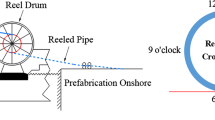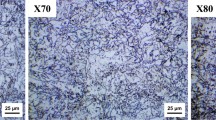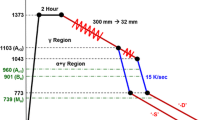Abstract
Creep deformation and the effect of strain-rate on stress-strain behavior of X-52, X-70 and X-80 pipeline steels at room temperature were studied using round tension test specimens. Depending on its chemical composition and the processing condition (as-received or fully annealed), a pipeline steel may exhibit a stress-strain curve with or without a yield point. The as-received and the annealed steels with both type of yielding behavior were creep tested at a constant stress either below or past the yield point / 0.2% offset yield strength. Independent of yielding behavior, significant post-yield creep deformation was observed in all the steels. The pre-yield creep, however, is strongly dependent on the yielding behavior. In the presence of a yield point, only a minor deformation was detected in the steels subject to the pre-yield creep. In the absence of a yield point, pre-yield creep deformation occurred to a relatively large extent. For the latter case, an annealing treatment further enhanced creep deformation. A strain-rate-dependent stress-strain behavior was also observed in all thesteels that show significant creep deformation. Dislocation mechanisms responsible for the creep behavior observed in the study are also provided in the paper.
Similar content being viewed by others
References
Z. Zhao, D. O. Northwood, C. Liu and Y. Liu, Journal of Materials Processing Technology 89/90 (1999) 569.
R. N. Parkins, in “Stress Corrosion Cracking-The Slow Strain-Rate Technique,” ASTM STP 665, edited by G. M. Ugiansky and J. H. Payer (American Society for Testing and Materials, Philadelphia, 1979) p. 5.
A. Oehlert and A. Atrens, Acta Metall. Mater. 42 (1994) 1493.
Idem., in “Parkings Symposium on Fundamental Aspects of Stress Corrosion Cracking,” edited by S. M. Bruemmer et al. (The Minerals, Metals & Materials Society, 1992) p. 255.
M. M. Festen, J. G. Erlings and R. A. Fransz, in Proc. First Int'l. Conf. on Environment-Induced Cracking of Metals, Oct. 2–7, 1988 (NACE, Houston) p. 229.
K. Ishikawa, H. Okuda, M. Maehara and Y. Kobayashi, in Experimental Mechanics, edited by Allison (Balkema, Rotterdam, 1998) p. 1349.
K. Ishikawa, H. Okuda and Y. Kobayashi, J. Mater. Sci. Lett. 17 (1998) 423.
W. K. Miller, Metall. Trans. A 22A (1991) 873.
W. H. Miller, R. T. Chen and E. A. Starke, ibid. 18A (1987) 1451.
T. H. Alden, ibid. 18A (1987) 51.
Idem., ibid. 18A (1987) 811.
Idem., ibid. 16A (1985) 375.
Z. A. Yang, Z. G. Wang and S. Q. Wang, Mater. Sci. Eng. A 102 (1988) 17.
H. Cimenoglu and E. S. Kayali, Scripta Metall. Mater. 24 (1990) 2437.
F. R. N. Nabarro, “Theory of Crystal Dislocations” (Oxford University Press, London, 1967).
J. P. Naylor and M. Guttmann, Met. Sci. 15 (1981) 433.
S. D. Mann and B. C. Muddle, Mater. Sci. Tech. 13 (1997) 299.
E. H. Jordan and A. D. Fred, Exp. Mech. 22 (1982) 354.
D. Uchic and W. D. Nix, Mat. Res. Soc. Symp. Proc. 460 (1997) 437.
T. Ogata, O. Umezawa and K. Ishikawa, Advances in Cryogenic Engineering (Materials) 36 (1990) 1233.
R. Dutton, “A Review of the Low-Temperature Creep Behaviour of Titanium,” AECL-11544, COG–96–70-I, Whiteshell Laboratories, Pinawa, Manitoba, Canada, 1996.
D. S. Wood, in “Dislocations and Mechanical Properties of Crystals,” edited by J. C. Fisher et al. (John Wiley & Sons, New York, 1957) 413.
D. Hull, “Introduction to Dislocations” (Pergamon Press, Oxford, 1965).
C. Y. Jeong, S. W. Nam and J. Ginsztler, J. Mater. Sci. 34 (1999) 2513.
Author information
Authors and Affiliations
Rights and permissions
About this article
Cite this article
Wang, SH., Zhang, Y. & Chen, W. Room temperature creep and strain-rate-dependent stress-strain behavior of pipeline steels. Journal of Materials Science 36, 1931–1938 (2001). https://doi.org/10.1023/A:1017545907676
Issue Date:
DOI: https://doi.org/10.1023/A:1017545907676




